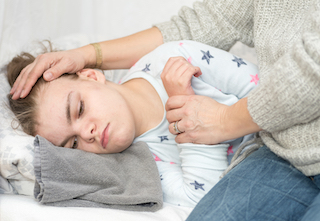 According to the Centers for Disease Control and Prevention, traumatic brain injury or TBI for short, is the leading cause of death and disability in children aged 0-4 and 15-19. Each year, approximately 1.7 million TBIs occur in the United States, 700,000 of which happen to children and teens aged 1-19. Children who’ve undergone TBIs can have lasting neurological and mental effects into adulthood such as the development of depression and anxiety.
According to the Centers for Disease Control and Prevention, traumatic brain injury or TBI for short, is the leading cause of death and disability in children aged 0-4 and 15-19. Each year, approximately 1.7 million TBIs occur in the United States, 700,000 of which happen to children and teens aged 1-19. Children who’ve undergone TBIs can have lasting neurological and mental effects into adulthood such as the development of depression and anxiety.
“Traumatic brain injuries can have detrimental effects on children’s long-term functioning and quality of life, as well as places burdens on families and communities,” Bina Ali, research scientist at the Pacific Institute for Research and Evaluation and author of a new study on TBI, told us. “We led this study to help set priorities for traumatic brain injury prevention programs.”
The study investigated the contribution of consumer product-related TBIs in children and adolescents across different age groups. Ali notes that a child’s age is important when looking at incidence and causes of these injuries and that researchers expected leading products and activities that contribute to TBI in children and adolescents would be different across developmental age groups.
“This was an observational study,” Ali told us. “We combined data from two data sources – National Electronic Injury Surveillance System (NEISS) and Injury Surveillance System–All Injury Program (NEISS-AIP) for the years 2010 through 2013 to examine our research questions. These data sources allowed us to closely look at nonfatal emergency department-treated traumatic brain injuries in children and adolescents.”
As well as lasting cognitive effects, the CDC found that TBIs in children who survive result on average in eight billion in work-related and medical costs. The study, published in Brain Injury, provides national estimates of traumatic brain injuries in children and adolescents at different developmental age groups. It also shows the leading everyday products and activities associated with those injuries.
“We found that TBIs related to floors and stairs are common in children and adolescents of all ages,” Ali told us. “Together, they account for about one in 10 cases of emergency department-treated traumatic brain injuries in children and adolescents. We also found that home furnishings and fixtures, primarily beds, were highest among infants and children up to four years old. Among children aged five to 19, traumatic brain injuries from sports and recreation, especially football, bicycles and basketball, were highest.”
Over 70 per cent of cases in children of all ages involved products regulated by the U.S. Consumer Products Safety Commission. Ten per cent of TBIs in children aged 0-4 were caused by bunk beds as well as another 10 per cent by stairs, and 10 per cent by floors. In children aged 5-9, the leading causes of TBI are floors and bike accidents. Football, basketball, soccer and bike accidents were the leading causes of TBI in children and adolescents aged 10-14.
The results are consistent with what Ali says he and his researchers expected based on previous research on traumatic brain injuries and falls. But their findings address an important gap in the literature, he notes, by identifying leading products and activities that contribute to traumatic brain injury in children and adolescents at different developmental age groups.
“The findings indicate priority areas for TBI prevention programs,” Ali told us. “TBI prevention strategies should include child behavior modification, adult education and supervision, as well as environment modifications. Educating youth athletes, parents, and coaches about the risks of traumatic brain injury, enforcing game and playground safety rules, and properly using safety gears, like helmets, are recommended measures. Also, removing tripping hazards, such as area rugs, improving lighting, avoiding hard surface playgrounds, using home safety devices, such as stair gates and stairway handrails, and avoiding use of prefabricated stairs can help reduce traumatic brain injuries.”
Patricia Tomasi is a mom, maternal mental health advocate, journalist, and speaker. She writes regularly for the Huffington Post Canada, focusing primarily on maternal mental health after suffering from severe postpartum anxiety twice. You can find her Huffington Post biography here. Patricia is also a Patient Expert Advisor for the North American-based, Maternal Mental Health Research Collective and is the founder of the online peer support group - Facebook Postpartum Depression & Anxiety Support Group - with over 1500 members worldwide. Blog: www.patriciatomasiblog.wordpress.com
Email: tomasi.patricia@gmail.com